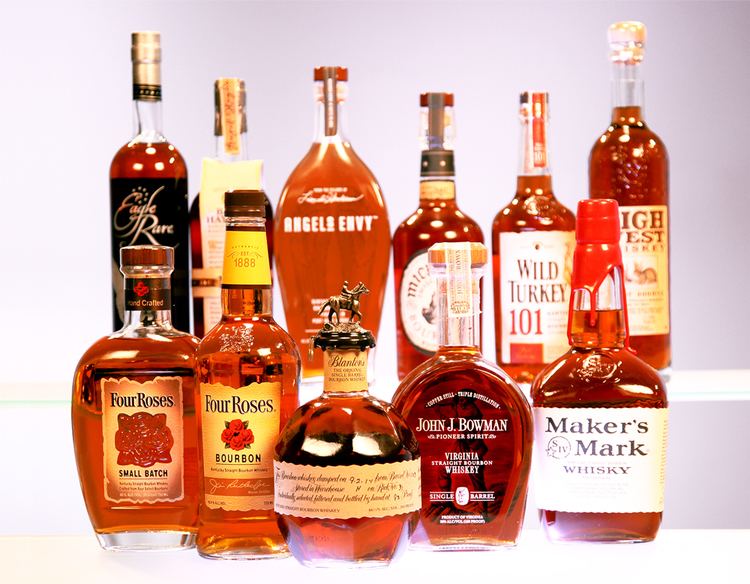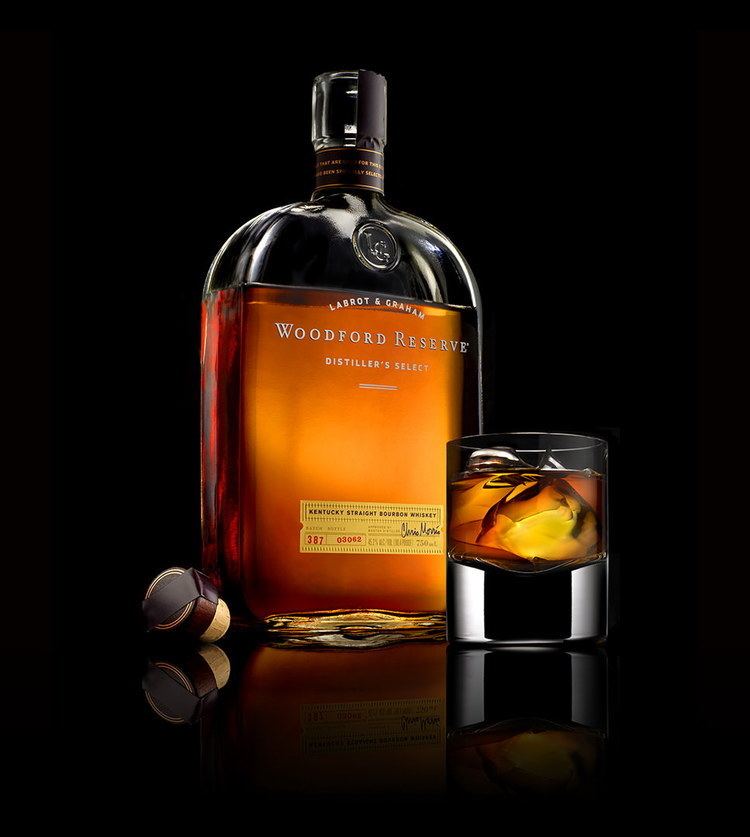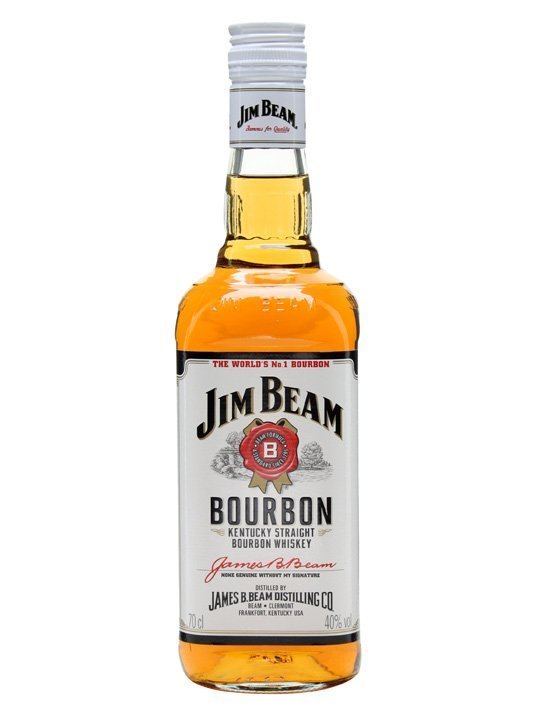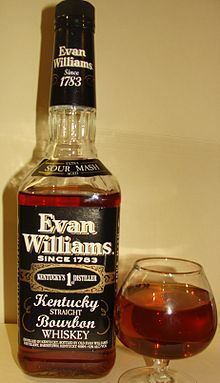 | ||
Similar Whisky, Scotch whisky, Distilled beverage, Brandy, Rum | ||
Types of alcohol the difference between bourbon whiskey sour mash
Bourbon whiskey /bɜːrbən/ is a type of American whiskey: a barrel-aged distilled spirit made primarily from corn. The name is ultimately derived from the French Bourbon dynasty, although it is disputed whether Bourbon County in Kentucky or Bourbon Street in New Orleans inspired the whiskey's name. Bourbon has been distilled since the 18th century. The use of the term "bourbon" for the whiskey has been traced to the 1820s, and the term began to be used consistently in Kentucky in the 1870s. While bourbon may be made anywhere in the United States, it is strongly associated with the American South, and with Kentucky in particular. As of 2014, the distillers' wholesale market revenue for bourbon sold within the U.S. is about $2.7 billion, and bourbon makes up about two-thirds of the $1.6 billion of U.S. exports of distilled spirits.
Contents
- Types of alcohol the difference between bourbon whiskey sour mash
- Types of alcohol about old cabin still true handmade bourbon whiskey
- History
- Legal requirements
- Geographic origin
- Production process
- Uses
- References

Types of alcohol about old cabin still true handmade bourbon whiskey
History

The origin of bourbon is not well documented. There are many conflicting legends and claims, some more credible than others. For example, the invention of bourbon is often attributed to Elijah Craig, a Baptist minister and distiller credited with many Kentucky firsts (e.g., fulling mill, paper mill, ropewalk) who is also said to have been the first to age the product in charred oak casks, a process which gives bourbon its reddish color and distinctive taste. Across the county line in Bourbon County, an early distiller named Jacob Spears is credited with being the first to label his product as Bourbon whiskey. Spears' home, Stone Castle, warehouse and spring house survive; one can drive by the Spears' home on Clay-Kiser Road.

Although still popular and often repeated, the Craig legend is apocryphal. Similarly, the Spears story is a local favorite, rarely repeated outside the county. There likely was no single "inventor" of bourbon, which developed into its present form only in the late 19th century. Essentially any type of grain can be used to make whiskey, and the practice of aging whiskey and charring the barrels for better flavor had also been known in Europe for centuries. The late date of the Bourbon County etymology has led Louisville historian Michael Veach to dispute its authenticity. He proposes that the whiskey was named after Bourbon Street in New Orleans, a major port where shipments of Kentucky whiskey sold well as a cheaper alternative to French cognac.

Distilling probably was brought to present-day Kentucky in the late 18th century by Scots, Scots-Irish, and other settlers (including English, Irish, Welsh, German and French) who began to farm the area in earnest. The spirit they made evolved, and became known as bourbon in the early 19th century due to its historical association with the geographic area known as Old Bourbon (this consisted of the original Bourbon County of Virginia as organized in 1785, a region that included much of today's Eastern Kentucky – including 34 of today's counties in Kentucky). This area included the current Bourbon County of Kentucky, which became a county of Kentucky when Kentucky was separated from Virginia as a new state in 1792.

When American pioneers pushed west of the Allegheny Mountains following the American Revolution, the first counties they founded covered vast regions. One of these original, huge counties was Bourbon, established in 1785 and named after the French royal family. While this vast county was being carved into many smaller ones, early in the 19th century, many people continued to call the region Old Bourbon. Located within Old Bourbon was the principal port on the Ohio River, Maysville, Kentucky, from which whiskey and other products were shipped. "Old Bourbon" was stencilled on the barrels to indicate their port of origin. Old Bourbon whiskey was different because it was the first corn whiskey most people had ever tasted. In time, bourbon became the name for any corn-based whiskey.

Although many distilleries operated in Bourbon County historically, there were no distilleries operating there between 1919, when Prohibition began in Kentucky, and late 2014, when a small distillery opened – a period of 95 years.

A refinement often dubiously credited to James C. Crow was the sour mash process, by which each new fermentation is conditioned with some amount of spent mash. Spent mash is also known as spent beer, distillers' spent grain, stillage, and slop or feed mash, so named because it is used as animal feed. The acid introduced by using the sour mash controls the growth of bacteria that could taint the whiskey and creates a proper pH balance for the yeast to work.
A concurrent resolution adopted by the United States Congress in 1964 declared bourbon to be a "distinctive product of the United States" and asked "the appropriate agencies of the United States Government... [to] take appropriate action to prohibit importation into the United States of whiskey designated as 'Bourbon Whiskey.'" Federal regulation now defines "bourbon whiskey" to only include "bourbon" produced in the United States.
In recent years, bourbon and Tennessee whiskey (which is sometimes regarded as a different type of spirit but which generally meets the legal requirements for being called bourbon) have enjoyed significant growth and popularity. The Distilled Spirits Council of the United States, the industry trade group, tracks sales of bourbon and Tennessee whiskey together.
According to the Distilled Spirits Council, during 2009–14, the volume of 9-liter cases of whiskey increased by 28.5% overall. Higher-end bourbon and whiskeys experienced the greatest growth: during 2009–14 the volume of the value segment increased by 12.1%, premium by 25.8%, high-end premium by 27.8% and super-premium by 123.8%. Gross supplier revenues (including federal excise tax) for U.S. bourbon and Tennessee whiskey increased by 46.7% over the 2009–14 period, with the greatest growth coming from high-end products (18.7% growth for value, 33.6% for premium, 44.5% for high-end premium, and 137.2% for super-premium). In 2014, more than 19 million nine-liter cases of bourbon and Tennessee whiskey were sold in the U.S., generating almost $2.7 billion in wholesale distillery revenue. U.S. exports of bourbon whiskey surpassed $1 billion for the first time in 2013; distillers hailed the rise of a "golden age of Kentucky bourbon" and predicted further growth. In 2014, it was estimated that U.S. bourbon whiskey exports surpassed $1 billion (making up the majority of the U.S. total of $1.6 billion in spirits exports). Major export markets for U.S. spirits are, in descending order: Canada, the United Kingdom, Germany, Australia and France. The largest percentage increases in U.S. exports were, in descending order: Brazil, the Dominican Republic, Bahamas, Israel and United Arab Emirates. Key elements of growth in the markets showing the largest increases have been changes of law, trade agreements, and reductions of tariffs, as well as increased consumer demand for premium-category spirits.
Legal requirements
Bourbon's legal definition varies somewhat from country to country, but many trade agreements require the name bourbon to be reserved for products made in the United States. The U.S. regulations for labeling and advertising bourbon apply only to products made for consumption within the United States; they do not apply to distilled spirits made for export. Canadian law requires products labeled bourbon to be made in the United States and also to conform to the requirements that apply within the United States. But in countries other than the United States and Canada, products labeled bourbon may not adhere to the same standards. For example, in the European Union, products labeled as bourbon are not required to conform to all of the regulations that apply within the United States, though they still must be made in the U.S.
The Federal Standards of Identity for Distilled Spirits (27 C.F.R. 5) state that bourbon made for U.S. consumption must be:
Bourbon has no minimum specified duration for its aging period. Products aged for as little as three months are sold as bourbon. The exception is straight bourbon, which has a minimum aging requirement of two years. In addition, any bourbon aged less than four years must include an age statement on its label.
Bourbon that meets the above requirements, has been aged for a minimum of two years, and does not have added coloring, flavoring, or other spirits may (but is not required to) be called straight bourbon.
Bourbon that is labeled blended (or as a blend) may contain added coloring, flavoring, and other spirits (such as un-aged neutral grain spirits); but at least 51% of the product must be straight bourbon.
Geographic origin
On May 4, 1964, the United States Congress recognized bourbon whiskey as a "distinctive product of the United States" by concurrent resolution. Bourbon may be produced anywhere in the United States where it is legal to distill spirits, but most brands are produced in Kentucky, where bourbon production has a strong historical association. Iron-free water that has been filtered through the high concentrations of limestone, unique to the area, is often touted by bourbon distillers in Kentucky as a signature step in the bourbon-making process.
On August 2, 2007, the U.S. Senate passed a resolution sponsored by Senator Jim Bunning (R-KY) officially declaring September 2007 to be National Bourbon Heritage Month, marking the history of bourbon whiskey. Notably, the resolution claimed that Congress had declared bourbon to be "America's Native Spirit" in its 1964 resolution. However, the 1964 resolution had not contained such a statement; it had declared bourbon to be a distinctive product identifiable with the United States (in a similar way that Scotch is considered identifiable with Scotland). The resolution was passed again in 2008.
As of 2014, approximately 95% of all bourbon is produced in Kentucky. The state has more than 5.3 million barrels of bourbon that are aging – a number that exceeds the state population.
Bardstown, Kentucky is home to the annual Bourbon Festival held each September. It has been called the "Bourbon Capital of the World" by the Bardstown Tourism Commission and the Kentucky Bourbon Festival organizers who have registered the phrase as a trademark. The Kentucky Bourbon Trail is the name of a tourism promotion program organized by the Kentucky Distillers' Association and aimed at attracting visitors to the distilleries in Kentucky, primarily including Four Roses (Lawrenceburg), Heaven Hill (Bardstown), Jim Beam (Clermont), Maker's Mark (Loretto), Town Branch (Lexington), Wild Turkey (Lawrenceburg), and Woodford Reserve (Versailles).
Tennessee is home to other major bourbon producers, though most of its producers do not call their finished product bourbon; Jack Daniel's is the most well-known example. The methods for producing Tennessee whiskey fit the characteristics of bourbon production, and "Tennessee whiskey" is legally defined under the North American Free Trade Agreement (NAFTA) and at least one other international trade agreement as the recognized name for a straight bourbon whiskey produced in Tennessee. It is also required to meet the legal definition of bourbon under Canadian law.
Although some producers have pointed to the use of a production process known as the Lincoln County Process as a characteristic that makes Tennessee whiskey distinct from bourbon, the U.S. regulations defining bourbon do not prohibit the use of that process when making bourbon, so Tennessee whiskey can generally be regarded as a particular type of bourbon. Prior to 2013, the use of the Lincoln County Process was not actually required for making products identified as Tennessee whiskey. However, on May 13, 2013, the Governor Bill Haslam of Tennessee signed House Bill 1084, requiring the Lincoln County process and the existing requirements for bourbon to be used for products identified as "Tennessee whiskey". As a grandfathering measure, the law exempted one small producer, Benjamin Prichard's. As U.S. federal law requires statements of origin on labels to be accurate, and various international trade agreements also codify this requirement, the Tennessee law effectively gives a firm definition to Tennessee whiskey.
Bourbon also has been made in other U.S. states as well.
Production process
The typical grain mixture for bourbon, known as the mash bill, is a minimum of 51% corn, with the remainder being rye, wheat, malted barley, or some combination of these. A mash bill that contains wheat instead of rye produces what is known as a wheated bourbon. The grain is ground and mixed with water. Usually, though not always, mash from a previous distillation is added to ensure a consistent pH across batches, and a mash produced in that manner is referred to as a sour mash. Finally, yeast is added and the mash is fermented. The fermented mash then is distilled to (typically) between 65% and 80% alcohol. Distillation was historically performed using an alembic or pot still until the continuous still was invented which made the distillation process much more economically efficient. However, column stills do not seem to produce the best flavored spirits when used by themselves, so in current bourbon production, most typically the spirit is initially distilled using a column still and then again in a "doubler" (alternatively known as a "thumper" or "retort") that is basically a pot still.
The resulting clear spirit, called "white dog", is placed in newly charred American oak barrels for aging, during which it gains color and flavor from the caramelized sugars in the charred wood. Changes to the spirit also occur due to evaporation and chemical processes such as oxidation. Bourbons gain more color and flavor the longer they mature. Maturity, not a particular age, is the goal. Bourbon can age too long and become woody and unbalanced.
After maturing, bourbon is withdrawn from the barrel, usually filtered and diluted with water, and bottled to at least 80 US proof (40% abv). Most bourbon whiskey is sold at 80 US proof. Other common proofs are 86, 90, and 100, and all "bottled in bond" bourbon is bottled at 100 proof. Some higher-proof bottlings are marketed as "barrel proof", meaning that they have not been diluted or have been only lightly diluted after removal from the barrels. Bourbon whiskey may be sold at less than 80 proof but must be labeled as "diluted bourbon".
After processing, barrels still contain some bourbon soaked into the wooden staves. This may be up to ten gallons of liquid, but is usually 2–3 gallons. After the first use, oak barrels cannot be used again for bourbon, and most of them are then sold to distilleries in Canada, Scotland, Ireland, Mexico, or the Caribbean for aging other spirits. They are also used for making various other barrel-aged products, including amateur and professional production of bourbon-barrel-aged beer, barbecue sauce, wine, hot sauce, and others.
The bottling operation for bourbon is the process of filtering, mixing together straight whiskey from different barrels (sometimes from different distilleries), dilution with water, blending with other ingredients (if producing blended bourbon), and filling of containers to produce the final product that is marketed to consumers. The phrase "bottled by", by itself, means only that. Only if the bottler operates the distillery that produced the whiskey may "distilled by" be added to the label.
Labeling requirements for Bourbon and other alcoholic beverages (including the requirements for what is allowed to be called Bourbon under U.S. law) are defined in the U.S. Code of Federal Regulations. No whiskey made outside the United States may be labeled "bourbon" or sold as "bourbon" inside the United States (and in various other countries that have trade agreements with the United States to recognize bourbon as a distinctive product of the United States).
Uses
Bourbon is served neat, diluted with water, over ice cubes ("on the rocks"), or mixed with soda and into cocktails, including the Manhattan, the Old Fashioned, the whiskey sour, and the mint julep. Bourbon is also used in cooking, and was historically used for medicinal purposes.
